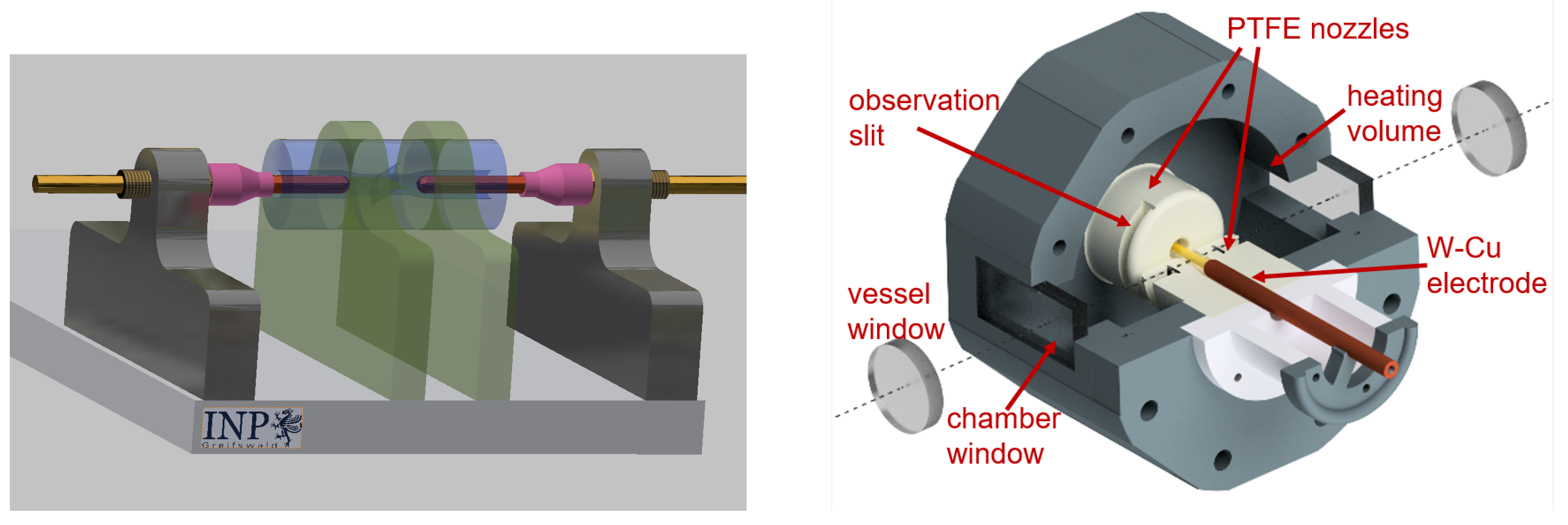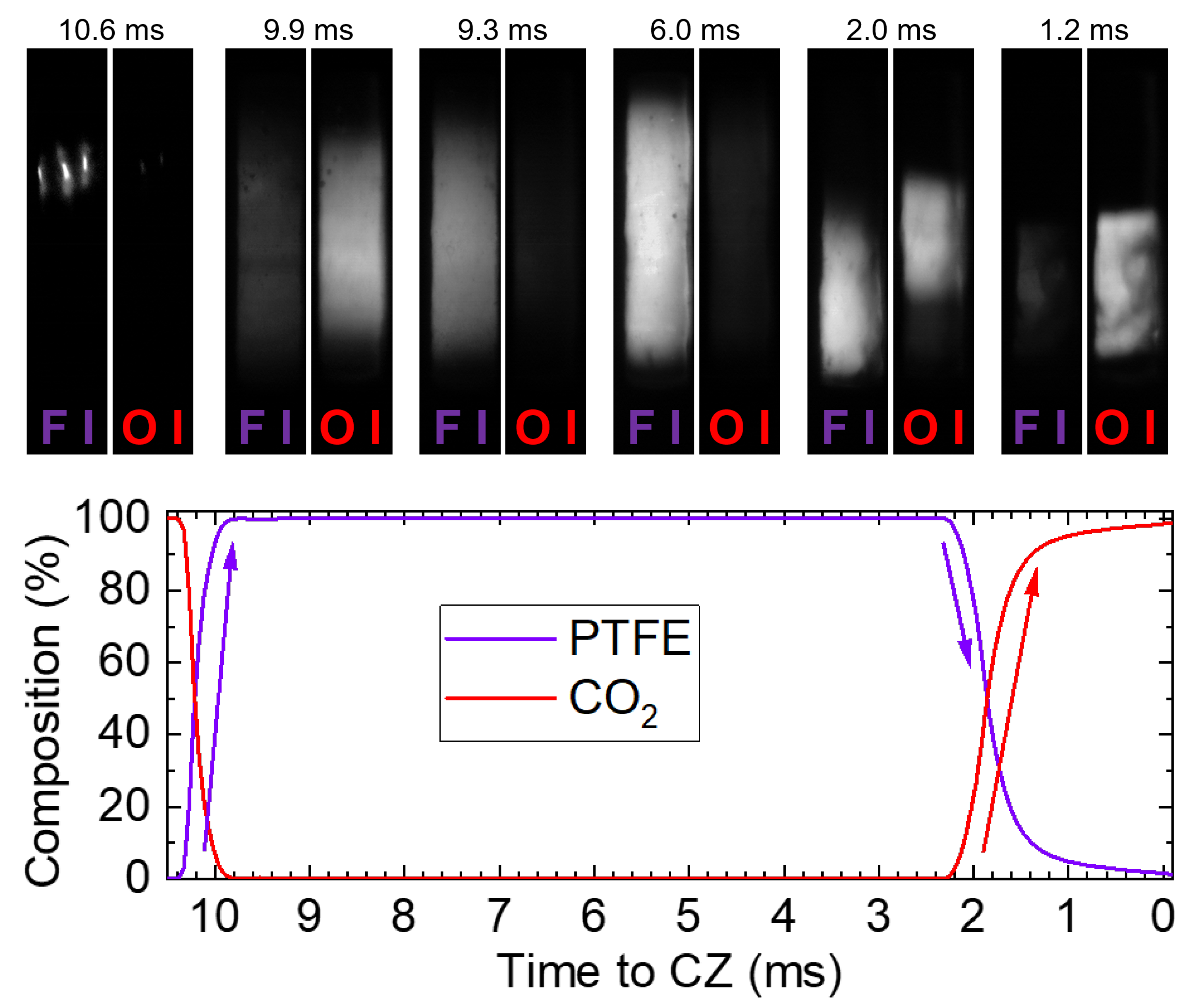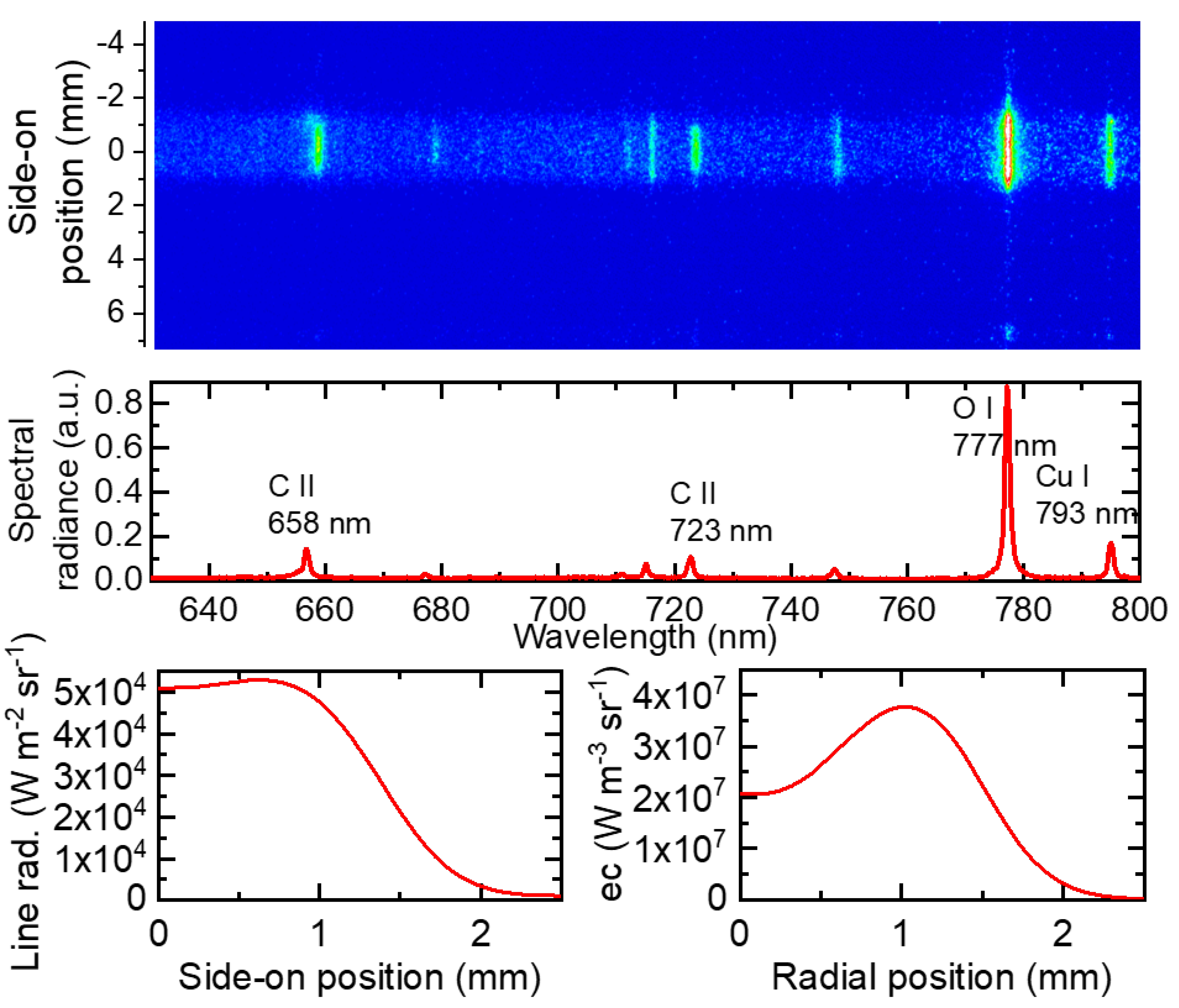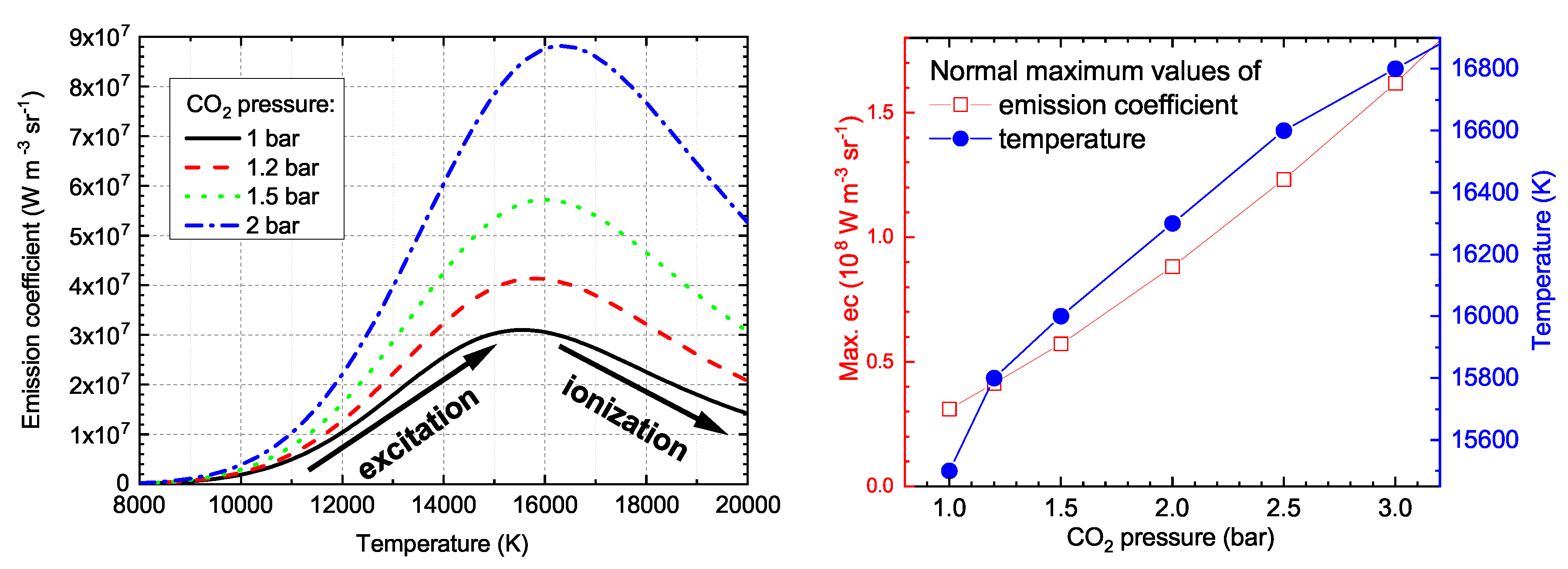Ablation-Dominated Arcs in CO2 Atmosphere—Part I: Temperature Determination near Current Zero
Abstract
:1. Introduction
- Reversal of the gas flow in the heating channel,
- Transition from an ablation-controlled to an axially blown arc,
- Arc constriction and finally extinction,
- Wall ablation that still occurs when the energy input by radiation from the arc is terminated, and
- Dielectric recovery of the electrode gap region.
- The first, more simple setup is applied to generate extra-high pressure built-up and strong influence of the wall ablation. Therefore, the nozzle is made of a single, long PTFE tube. The influence of ignition wire and surrounding gas (ambient air) during the early stage of the arc discharge have been investigated in [16]. In the present work, the focus is set on the gas flow reversal as well as the detection limits for the determination of plasma temperature profiles around CZ. For these issues, no surrounding chamber is needed.
- The second setup is a model self-blast circuit breaker in a CO atmosphere with optical access via the windows. It consists of two nozzles surrounding the electrodes and forming a heating channel which leads into the heating volume. Earlier experiments were carried out with the optical observation at the position of the heating channel and in the high-current phase [17]. Hence, the plasma emission from the central parts of the arc is influenced by the axial flow of hot gas in the heating channel, i.e., along the line of sight. The gas flow into the heating volume partly forces the plasma into the heating channel and the emission region exceeds the nozzle diameter, showing turbulence and deviation from the expected bi-convex structure that is needed for plasma temperature determination. To overcome these problems, for the experiments reported here the observation position was shifted away from the heating channel and towards the electrodes. As described below, this was realized by insertion of quartz windows into the nozzles.
2. Materials and Methods
2.1. Geometry of Electrodes and Nozzles
2.2. Optical Setup
3. Results
3.1. Video Observation and Flow Reversal
3.2. OES of High-Current Phase Using High-Speed Camera
3.3. Optical Emission Spectroscopy near to Current Zero
3.3.1. Oes with High–Speed Camera
3.3.2. OES with Intensified Camera
4. Discussion
4.1. General
4.2. OES Using HSC
4.3. OES with ICCD
5. Conclusions
Supplementary Materials
Author Contributions
Funding
Acknowledgments
Conflicts of Interest
Abbreviations
| CB | Circuit Breaker |
| CO | carbon dioxide |
| CFD | computational fluid dynamics |
| CZ | current zero |
| DFO | double frame optics |
| ICCD | intensified charge coupled device |
| HSC | high–speed camera |
| LTE | local thermal equilibrium |
| MoS | molybdenum disulfide |
| OAS | optical absorption spectroscopy |
| OES | optical emission spectroscopy |
| PTFE | polytetrafluoroethylene |
| PMMA | polymethyl methacrylate |
| SF | sulfur hexafluoride |
| W–Cu | tungsten–copper |
References
- Seeger, M. Future Perspectives on High Voltage Circuit Breaker Research. Plasma Phys. Technol. 2015, 2, 271–279. [Google Scholar]
- Seeger, M. Perspectives on research on high voltage gas circuit breakers. Plasma Chem. Plasma Process. 2015, 35, 527–541. [Google Scholar] [CrossRef]
- Glaubitz, P.; Stangherlin, S.; Biasse, J.; Meyer, F.; Dallet, M.; Pruefert, M.; Kurte, R.; Saida, T.; Uehara, K.; Prieur, P.; et al. CIGRE position paper on the application of SF6 in transmission and distribution networks. Electra 2014, 34, 34–39. [Google Scholar]
- Christophorou, L.; Olthoff, J.K.; Green, D.S. Gases for Electrical Insulation and Arc Interruption: Possible Present and Future Alternatives to Pure SF6; NIST Technical Note 1425; Nov. 1997; pp. 1–44. Available online: https://www.nist.gov/publications/gases-electrical-insulation-and-arc-interruption-possible-present-and-future (accessed on 9 September 2020).
- Robin-Jouan, P.; Bousoltane, K.; Kieffel, Y.; Trepanier, J.Y.; Camarero, R.; Arabi, S.; Pernaudat, G. Analysis of last development results for high voltage circuit-breakers using new g3 gas. Plasma Phys. Technol. 2000, 33, 2583–2590. [Google Scholar] [CrossRef]
- Godin, D.; Trepanier, J.Y.; Reggio, M.; Zhang, X.D.; Camarero, R. Modelling and simulation of nozzle ablation in high-voltage circuit-breakers. J. Phys. D Appl. Phys. 2000, 33, 2583–2590. [Google Scholar] [CrossRef]
- Wu, Y.; Wang, C.; Sun, H.; Murphy, A.B.; Rong, M.; Yang, F.; Chen, Z.; Niu, C.; Wang, X. Properties of C4F7N–CO2 thermal plasmas: Thermodynamic properties, transport coefficients and emission coefficients. J. Phys. D Appl. Phys. 2007, 51, 155206. [Google Scholar] [CrossRef]
- Seeger, M.; Smeets, R.; Yan, J.; Ito, H.; Claessens, M.; Dullni, E.; Falkingham, L.; Franck, C.M.; Gentils, F.; Hartmann, W.; et al. Recent Trends in Development of High Voltage Circuit Breakers with SF6 Alternative Gases. Plasma Phys. Technol. 2017, 4, 8–12. [Google Scholar] [CrossRef]
- Stoller, P.C.; Seeger, M.; Iordanidis, A.A.; Naidis, G.V. CO2 as an arc interruption medium in gas circuit breakers. IEEE Trans. Plasma Sci. 2013, 41, 2359–2369. [Google Scholar] [CrossRef]
- Guo, Z.; Liu, S.; Pu, Y.; Zhang, B.; Li, X.; Tang, F.; Lv, Q.; Jia, S. Study of the arc interruption performance of CO2 gas in high-voltage circuit breaker. IEEE Trans. Plasma Sci. 2019, 47, 2742–2751. [Google Scholar] [CrossRef]
- Kozakov, R.; Kettlitz, M.; Weltmann, K.D.; Steffens, A.; Franck, C.M. Temperature profiles of an ablation controlled arc in PTFE: I. Spectroscopic measurements. J. Phys. D Appl. Phys. 2007, 40, 2499–2506. [Google Scholar] [CrossRef]
- Methling, R.; Franke, S.; Uhrlandt, D.; Gorchakov, S.; Reichert, F.; Petchanka, A. Spectroscopic Study of Arc Temperature Profiles of a Switching-off Process in a Model Chamber. Plasma Phys. Technol. 2015, 2, 163–166. [Google Scholar]
- Ruchti, C.B.; Niemeyer, L. Ablation controlled arcs. IEEE Trans. Plasma Sci. 1986, 14, 423–434. [Google Scholar] [CrossRef]
- Bort, L.; Schultz, T.; Franck, C.F. Determining the time constant of arcs at arbitrary current levels. Plasma Phys. Technol. 2019, 5, 175–179. [Google Scholar] [CrossRef]
- Schultz, T.; Hammerich, B.; Bort, L.; Franck, C.F. Improving interruption performance of mechanical circuit breakers by controlling pre-current-zero wave shape. High Volt. 2019, 4, 122–129. [Google Scholar] [CrossRef]
- Methling, R.; Khakpour, A.; Wetzeler, S.; Uhrlandt, D. Investigation of an ablation–dominated arc in a model chamber by optical emission spectroscopy. Plasma Phys. Technol. 2017, 4, 153–156. [Google Scholar] [CrossRef]
- Eichhoff, D.; Kurz, A.; Kozakov, R.; Gött, G.; Uhrlandt, D.; Schnettler, A. Study of an ablation–dominated arc in a model circuit chamber. J. Phys. D Appl. Phys. 2012, 45, 305204. [Google Scholar] [CrossRef]
- Seeger, M.; Tepper, J.; Christen, T.; Abrahamson, J. Experimental study on PTFE ablation in high voltage circuit-breakers. J. Phys. D Appl. Phys. 2006, 39, 5016–5024. [Google Scholar] [CrossRef]
- Seeger, M.; Niemeyer, L.; Christen, T.; Schwinne, M.; Dommerque, R. An integral arc model for ablation controlled arcs based on CFD simulations. J. Phys. D Appl. Phys. 2006, 39, 2180–2191. [Google Scholar] [CrossRef]
- Methling, R.; Götte, N.; Uhrlandt, D. Ablation-Dominated Arcs in CO2 atmosphere—Part II: Molecule emission and absorption. Preprints 2020. [Google Scholar] [CrossRef]
- Kramida, A.; Ralchenko, Y.; Reader, J.; Team, N.A. NIST Atomic Spectra Database (Version 5.7.1); National Institute of Standards and Technology: Gaithersburg, MD, USA, 2019. Available online: http://physics.nist.gov/asd (accessed on 9 September 2020).
- Kurucz, R.L.; Bell, B. Atomic Line Data. Kurucz CD-ROM No. 23. Smithsonian Astrophyical Observatory. 1995. Available online: http://www.cfa.harvard.edu/amp/ampdata/kurucz23/sekur.html (accessed on 9 September 2020).
- Methling, R.; Franke, S.; Uhrlandt, D.; Gortschakow, S.; Panousis, E. Spectroscopic measurements of arc temperatures in a model HV circuit breaker. Plasma Phys. Technol. 2015, 2, 167–170. [Google Scholar]










© 2020 by the authors. Licensee MDPI, Basel, Switzerland. This article is an open access article distributed under the terms and conditions of the Creative Commons Attribution (CC BY) license (http://creativecommons.org/licenses/by/4.0/).
Share and Cite
Methling, R.; Khakpour, A.; Götte, N.; Uhrlandt, D. Ablation-Dominated Arcs in CO2 Atmosphere—Part I: Temperature Determination near Current Zero. Energies 2020, 13, 4714. https://doi.org/10.3390/en13184714
Methling R, Khakpour A, Götte N, Uhrlandt D. Ablation-Dominated Arcs in CO2 Atmosphere—Part I: Temperature Determination near Current Zero. Energies. 2020; 13(18):4714. https://doi.org/10.3390/en13184714
Chicago/Turabian StyleMethling, Ralf, Alireza Khakpour, Nicolas Götte, and Dirk Uhrlandt. 2020. "Ablation-Dominated Arcs in CO2 Atmosphere—Part I: Temperature Determination near Current Zero" Energies 13, no. 18: 4714. https://doi.org/10.3390/en13184714
APA StyleMethling, R., Khakpour, A., Götte, N., & Uhrlandt, D. (2020). Ablation-Dominated Arcs in CO2 Atmosphere—Part I: Temperature Determination near Current Zero. Energies, 13(18), 4714. https://doi.org/10.3390/en13184714





